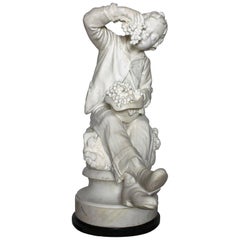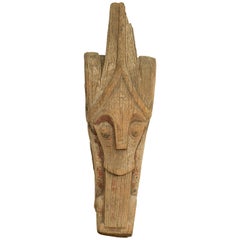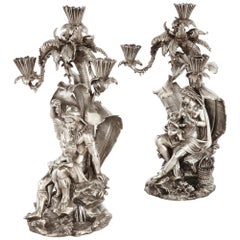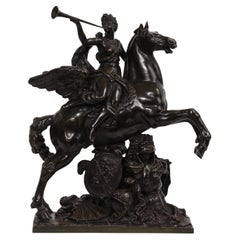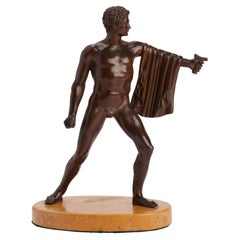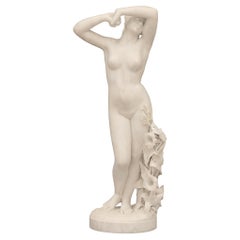19th Century Figurative Sculptures
to
405
3,736
1,146
3,736
9,113
2,769
2,285
3,221
2,050
304
156
563
568
253
498
569
672
387
268
275
224
148
138
79
77
36
30
29
19
13
12
7
6
4
2
1
1
2,042
1,700
1,001
828
665
1,870
1,594
3,059
1,592
712
250
246
Height
to
Width
to
3,736
3,736
3,736
73
29
27
25
19
Period: 19th Century
Italian 19th Century Carrara Marble Sculpture of a Boy by Raffaele Belliazzi
By Raffaele Belliazzi
Located in Los Angeles, CA
A very fine Italian 19th century carved carrara marble sculpture Group Titled "LA GIOIA NELL'INNOCENZA DOPO IL LAVORO" (The Joy of Innocence After Labour) by Professor Raffaele Belliazzi (Italian, 1835-1917). The slender figure of the young boy, seated and resting on a rock with his hanging legs crossed and joyfully eating a cluster of grapes picked from his hat that is resting on his lap. The intricate carving of his shirt, jacket, pants, hat and boots with fine attention details such at the stitching, buttons, the hem on his pants, the wear on the soles of his boots and the features on his face makes this one of Belliazzi's finest known works. The sculpure rests on a dark green serpentine marble pedestal with a rotating top. Signed: Profor. Belliazzi, Carrara. Florence, circa 1870-1880.
It may be possible to identify the present marble sculpture of a boy eating grapes...
Category
Italian Expressionist Antique 19th Century Figurative Sculptures
Materials
Marble, Carrara Marble
$58,950 Sale Price
30% Off
Large Hand Carved Singa Singa Tribal Carving from the Batak People, Sumatra
Located in Yonkers, NY
A large antique hand carved tribal sculpture from the Batak People, northern Sumatra, called a Singa Singa. Behold the striking allure of this large antique hand-carved Singa Singa, ...
Category
Indonesian Tribal Antique 19th Century Figurative Sculptures
Materials
Wood
Pair of Figural Candelabra by Elkington, Mason & Co
Located in London, GB
Pair of figural candelabra by Elkington, Mason & Co
English, circa 1860
Height 44cm, width 26cm, depth 20cm
This pair of three light figural candelabra is made of silvered-bronze. The candelabra take the form of a male and female figure in exotic dress...
Category
English Victorian Antique 19th Century Figurative Sculptures
Materials
Silver Plate, Bronze
$48,312 / set
Large Patinated Bronze Group of Fame After the Model by Antoine Coysevox
By Coyzevox
Located in New York, NY
A Marvelous and Large 19th Century French Patinated Bronze group of Fame After the Model by Antoine Coysevox. The sculpture depicts the allegorical figure of Fame seated side-saddle...
Category
French Louis XIV Antique 19th Century Figurative Sculptures
Materials
Bronze
A neoclassic Grand Tour bronze depicting a warrior, Rome 1840.
Located in Milan, IT
Extremely refined neoclassical Grand Tour bronze sculpture, lost wax process, depicting a warrior Protesilao. Oval base made out of yellow marble from Siena. Rome, Italy 1st half od ...
Category
Italian Antique 19th Century Figurative Sculptures
Materials
Marble, Bronze
Italian 19th Century White Carrara Marble Statue of a Beautiful Maiden
Located in West Palm Beach, FL
A stunning and very high quality Italian 19th century white Carrara marble statue of a beautiful maiden. The beautiful statue is raised by a circular base with a wonderfully executed...
Category
Italian Antique 19th Century Figurative Sculptures
Materials
Marble
Bronze Statue of the Roman Greek Wrestler Milo of Croton After Dumont
By Jacques-Edme Dumont
Located in Vancouver, British Columbia
A fairly large 19th century French bronze statue of the Milo of Croton on a stepped marble base after the original marble statue by sculptor Edme Dumont (1...
Category
French Neoclassical Antique 19th Century Figurative Sculptures
Materials
Bronze
Sculpture Scipione Tadolini the Greek Slave Second Half of the 19th Century
By Scipione Tadolini
Located in SAINT-JEAN-CAP-FERRAT, FR
Scipione Tadolini was a skilled sculptor whose broad talent covered the neoclassic to the romantic movements. His ancestors from a dynasty of Roman sculptors exerted a profound and lasting influence on the artistic production of the Eternal City. The Greek Slave fully demonstrates his masterly talent and serves as a reminder of antique models and the orientalist influences characterising the second half of the 19th century.
Scipione Tadolini graduated from the Roman Academy and worked with his father on a series of celebrated portraits and ecclesiastical sculptures for Roman churches including a bust of Cardinal Giuseppe Alberghini for the Gesù (1847) and portraits of various members of the Cini family for the Church of Sant’Andrea della Valle (1844, 1846). Tadolini is also known as the author of a number of large-scale monuments for patrons around the world including an equestrian group of Simon Bolivar for the city of Lima, Peru. One of his best known sculptures is The Greek Slave which appears in his work from the late 1850s forward.The Greek Slave was created in several sizes in two variations: with the figure’s hand either raised to her chest or to her chin. The small number of versions all indicate the sculptor’s careful attention to the human form and passion with exoticism, which can be noticed through the tumbling folds of the present figure's headdress and the finely articulated jewellery...
Category
Italian Neoclassical Antique 19th Century Figurative Sculptures
Materials
Marble
Pair of Metal and Wood Floral Garnitures
Located in Palm Beach, FL
Pair of antique Italian garnitures with floral tole bouquets in classical wood urns retaining their original paint.
Category
Italian Rococo Revival Antique 19th Century Figurative Sculptures
Materials
Metal
$3,900 / set
Large Meissen Porcelain Figurine Group 'Apollo & Daphne', By Juechtzer, Ca. 1860
By Christian Gottfried Juechtzer, Meissen Porcelain
Located in Vienna, AT
Excellent large and rare Meissen figurine group from the 19th century:
Apollo clothed with a cloak embraces Daphne from behind, who is fleeing from him and has already frozen into a ...
Category
German Classical Roman Antique 19th Century Figurative Sculptures
Materials
Porcelain
Rare and Important Late 19th Century Over Life Size Bronze Torchere by J Coutan
Located in Long Island City, NY
A Rare and Important Late 19th Century Over Life Size Bronze Torchere by J Coutan and Thiebaut Freres
Jules-Félix Coutan
Modeled as a classically clad female musician holding a “tu...
Category
French Belle Époque Antique 19th Century Figurative Sculptures
Materials
Bronze
Meissen, Germany. Porcelain figurine of young man in elegant attire.
Located in København, Copenhagen
Meissen, Germany. Porcelain figurine of a young man in elegant attire.
Hand-painted in polychrome colors.
19th century.
Marked.
In perfect condition.
First factory quality.
Dimensio...
Category
German Rococo Antique 19th Century Figurative Sculptures
Materials
Porcelain
Study of a Satyr - Italy, early 19th century
Located in Bruxelles, BE
Study of a Satyr
Bronze, cast using the lost-wax (cire perdue) method
Italy, early 19th century
14 x 7 x 10 cm
This evocative bronze sculpture represents a satyr, the half-human, h...
Category
Italian Modern Antique 19th Century Figurative Sculptures
Materials
Bronze
Large 19th Century Italian 'Spinario' Bronze Sculpture on Stand
Located in Hamilton, Ontario
Large 19th century Italian 'Spinario' bronze sculpture on stand. This is a 19th century copy and the original is in the Capitaline Museum.
Category
Italian Antique 19th Century Figurative Sculptures
Grand Tour Verdigris Marble After Giambologna, The Abduction of a Sabine Woman'
Located in West Palm Beach, FL
Grand Tour Verdigris Marble After Giambologna, The Abduction of a Sabine Woman'
Italy, Mid- 19th century, Attributed to the workshops of Benedetto Bosch...
Category
Italian Renaissance Antique 19th Century Figurative Sculptures
Materials
Marble
19th Century European Marble Mortar
Located in High Point, NC
This 19th Century European marble mortar is a finely hand-carved piece that blends historic utility with sculptural elegance. Crafted from richly veined gray marble with streaks of w...
Category
European Antique 19th Century Figurative Sculptures
Materials
Marble
A Bronze Figure of the 1st Century CE Roman ‘Fisherman’, 19th Century
Located in ARMADALE, VIC
A Bronze Figure of the 1st Century CE Roman ‘Fisherman’, 19th Century
Provenance:
Private Australian Collection.
Description:
The male figure cast wearing a tunic and...
Category
French Antique 19th Century Figurative Sculptures
Materials
Bronze
Italian 19th century Neo-Classical st. Alabaster statue of The Three Graces
Located in West Palm Beach, FL
A beautiful Italian 19th century Neo-Classical st. Alabaster statue of The Three Graces. This wonderful Alabaster statue is raised by its original oval base with mottled edges and de...
Category
Italian Antique 19th Century Figurative Sculptures
Materials
Alabaster
19th Century Spectacular Clay Goddess of Summer in a Matching Pedestal
Located in Miami, FL
19th century spectacular clay Goddess of summer.
Category
Italian Neoclassical Antique 19th Century Figurative Sculptures
Materials
Clay
$6,720 Sale Price
20% Off
An Antique French Bronze signed Auguste Moreau, Late 19th Century
Located in Lambertville, NJ
A late 19th Century Art Nouveau patinated bronze sculpture of a young boy with instrument. Artist signed Auguste Morea, with the French bronze hallmark on base. 24 inches tall
Category
Art Nouveau Antique 19th Century Figurative Sculptures
Materials
Bronze
Antique Bronze Sculpture of Hebe & Jupiter's Eagle
Located in Wormelow, Herefordshire
An antique bronze sculpture depicting Hebe and Jupiter's eagle, after Laurent-Honore Marqueste.
Dating to circa 1890, the statue depicts a female figure standing nude on a rocky out...
Category
French Neoclassical Antique 19th Century Figurative Sculptures
Materials
Bronze
F. Charpentier, 19th Century Nude Bronze of a Young Girl Dancing
Located in Brighton, Sussex
A very good quality 19th century bronze study of a young girl nude dancing, entitled; 'La Chanson' (The Song)
Signed;
Félix Charpentier (10 January 1858 in Bollène in Vaucluse – 19...
Category
French Antique 19th Century Figurative Sculptures
Materials
Bronze
Antique Meiji Signed Japanese Figural Woman & Lantern Incense Burner with Base
Located in Hamilton, Ontario
This large antique Meiji period Japanese patinated and polychromed bronze is signed by an unknown artist and presumed to have been made in approximately 1880 in the period Meiji styl...
Category
Japanese Meiji Antique 19th Century Figurative Sculptures
Materials
Bronze
Mrs Devil 'Hall Figurine Attributed to Francesco Toso, 1875-1890
Located in Madrid, ES
This is a mephistophelic figure in solid wood carved of "Mrs. Devil" in the form of a hall support. Italy 1875-1890.
Measure: Height 185 cm -
Good condition,
Mother of pearl eyes.
Category
Italian Baroque Antique 19th Century Figurative Sculptures
Materials
Wood
French Bronze of 'Sappho', by Jean Baptiste Clesinger, 19th Century
Located in New York, NY
Inscribed F. Barbedienne with the Collas reduction.
Category
French Antique 19th Century Figurative Sculptures
Materials
Bronze
Life Size Orientalist Figurative Bronze Torchiere
Located in New York, US
Our extraordinary patinated bronze torchiere depicting a female slave comes from the firm of Lacarrière Frères & Delatours. Signed "Lacarrière Freres & Delatours", "Paris 1880". Fitted for electricity in the late nineteenth century, but currently in need of sockets and wiring. Provenance: Rochelle Sepenuk, New York, NY.
The firm of Auguste Lacarrière sent exhibits to the the first International Exhibition in London in 1851. At that time they seem to have occupied two Paris addresses, 9 rue St Elizabeth and 55 rue Meslay, as well as having another outlet in Limoges. They are recorded as showing "specimens of lustres, sconces, chandeliers, medallions, etc..". By the 1862 Exhibition they were only recorded at the Sainte Elizabeth address and showed, "appareils à gaz de fonte, de zinc et de bronze." Nevertheless, their exhibit was highly praised and the business, now called A. Lacarrière, Père et Fils...
Category
French Antique 19th Century Figurative Sculptures
Materials
Bronze
Pair of Cold Painted Orientalist Figures
Located in Palm Beach, FL
Pair of antique French Moroccan figures cold painted over spelter with striking detail, colorfully dressed and ready for action with one holding a rifle.
Category
French Moorish Antique 19th Century Figurative Sculptures
Materials
Spelter
$1,250 / set
Antique Austrian Bronze Sculpture of Napoleon on Horseback, after Alois Hernick.
Located in New Orleans, LA
Antique 19th Century Austrian Figural Bronze Sculpture on Green Marble Base of Napoleon on Horseback, after Alois Hernick (1870-1939).
Category
Austrian Antique 19th Century Figurative Sculptures
Materials
Marble, Bronze
A spectacular Italian 19th century Alabastro Fiorito and Ormolu statue
Located in West Palm Beach, FL
A spectacular and extremely high quality Italian 19th century Alabastro Fiorito and Ormolu statue. This striking statue is raised on a most impressive rectangular Alabastro Fiorito m...
Category
Italian Antique 19th Century Figurative Sculptures
Materials
Alabaster, Ormolu
Antique Seated Greek God Hermes Patinated Grand Tour Cast Bronze Sculpture
Located in Hamilton, Ontario
This large and substantial cast bronze sculpture is unsigned, but presumed to have been made in circa 1880 for the Grand Tour. The sculpture depicts the Greek god Hermes...
Category
Italian Greek Revival Antique 19th Century Figurative Sculptures
Materials
Marble, Bronze
19th Century Group of Three Parcel Gilt Carved Wood Figures of Roman Soldiers
Located in Chapel Hill, NC
Group of three painted and parcel gild figures of Roman soldiers, two in reclining positions one seated. All three figures wearing helmets, breastplates and other protective armor in...
Category
Italian Neoclassical Antique 19th Century Figurative Sculptures
Materials
Gold Leaf
Miniature Cast Bronze Grand Tour Architectural Sculpture of the Trajan Column
Located in Hamilton, Ontario
This miniature cast bronze architectural model of the Trajan Column dates to the 19th century to commemorate one of the Grand Tours of Europ...
Category
French Victorian Antique 19th Century Figurative Sculptures
Materials
Bronze
19TH CENTURY GOLD GILT BRONZE DEMETRE H CHIPARUS SiGNED NEWSPAPER BOY STATUE
Located in West Sussex, Pulborough
Royal House Antiques
Royal House Antiques is delighted to offer for sale this stunning late 19th century Paris France made by the genius that was Demetre H Chiparus gold gilt bronze...
Category
French Victorian Antique 19th Century Figurative Sculptures
Materials
Bronze
$7,674 Sale Price
20% Off
French Louis XV Style Gold Gilt Bronze Figural Centerpiece Bowl Sculpture
Located in Philadelphia, PA
Antique French Louis XV Style Gold Gilt Bronze Figural Centerpiece Bowl Sculpture w/ Swan. A Napoleon III gilt bronze centerpiece surmounted by winged maiden and winged swan pulling ...
Category
Unknown Louis XV Antique 19th Century Figurative Sculptures
Materials
Bronze
Sculpture of Plaster, signed Gallé and dated -93 (1893)
Located in Stockholm, SE
A plaster sculpture by André Vauthier-Galle (1818–1899). A seated male figure with his hands behind his back. Executed in a very realistic way. The sculpture very much reminds of Auguste Rodins "The Thinker" in its pose.
The sculpture has a great patina.
The sculpture comes from the workshop of the Swedish painter and sculptor Jonas Åkesson...
Category
French Antique 19th Century Figurative Sculptures
Materials
Plaster
$4,012 Sale Price
20% Off
Bronze sculpture of a Cupid, after Lemire
Located in Paris, FR
Green patina bronze proof of a cupid stringing his bow, after a marble original presented at the 1814 Salon by Charles Gabriel Sauvage dit Lemire (1741-1827). Love is shown seated an...
Category
French Antique 19th Century Figurative Sculptures
Materials
Bronze
Big A.FALGUIERE france Art Nouveau large bronze "Diana" circa 1890.
Located in Rio De Janeiro, RJ
Incredible A.Falguiere large france bronze "Diana" with perfect patina circa 1890 Art Nouveau.
Category
French Art Nouveau Antique 19th Century Figurative Sculptures
Materials
Bronze
Antique Italian Alabaster Sculpture of Leda & the Swan
Located in Wormelow, Herefordshire
A mid-late 19th century antique Italian alabaster sculpture depicting Leda and the Swan mounted on a green marble base. This figure of neoclassical interest is brilliantly detailed, ...
Category
Italian Neoclassical Antique 19th Century Figurative Sculptures
Materials
Alabaster, Marble
Antique Meissen Porcelain Figure, Noble Gentleman with Gold Watch
Located in København, Copenhagen
Antique Meissen porcelain figure. A noble gentleman with a gold watch.
Late 19th century.
Measures: 19 x 9 cm.
In excellent condition.
Signed.
1st F...
Category
German Rococo Revival Antique 19th Century Figurative Sculptures
Materials
Porcelain
Pair Staffordshire 'Simpson & Brown' Generals on Horseback
Located in Chelmsford, Essex
Pair of Staffordshire figures with a military theme which feature two generals each holding a flag, seated on horseback. The pieces are titled, ''G. BROWN' and 'GNL SIMPSON'' to the fronts. Dull gilt titles and embellishment. These represent Sir James Simpson (1792-1868) served with the Grenadier Guards...
Category
English Victorian Antique 19th Century Figurative Sculptures
Materials
Earthenware
Large French 19th Century Parcel Silver &Gilt Bronze Sculpture of a Man & Woman
Located in New York City, NY
Important French 19th century multi figural bronze sculpture of a male and female, in a warm brown patina with unusual and rare parcel gilt and silver intricate decoration.
Depictin...
Category
French Neoclassical Antique 19th Century Figurative Sculptures
Materials
Bronze
Italian Sculpture: "Greek Warrior with Spear and Shield" Bronze 19th Century
Located in Madrid, ES
Sculptor of the 19th century,
Sculpture: "Greek warrior with spear and shield", bronze,
light brown patina with dark accents.
Measure: H. 38.5 cm.
Good condition.
Category
Italian Baroque Antique 19th Century Figurative Sculptures
Materials
Bronze
Antique Pair of Italian Bronze Busts: Dionysus and Ariadne, 19th Century
Located in Madrid, ES
This exquisite pair of antique Italian bronze busts represents the timeless allure of the Grand Tour era, featuring depictions of Dionysus and Ariadn...
Category
Antique 19th Century Figurative Sculptures
Materials
Bronze
Italian 19th Century White Carrara Marble Statue Theseus and the Minotaur
Located in West Palm Beach, FL
A very handsome Italian 19th century white Carrara marble statue of Theseus and the Minotaur. The statue is raised on an oval base with the Minotaur lying in defeat as Theseus is poised to strike the monster. The story of Theseus and the Minotaur has many renditions, one of them is the following:
King Minos of Crete had conquered the Athenians and demanded that, at nine-year intervals, seven Athenian boys and seven Athenian girls were to be sent to Crete to be devoured by the Minotaur, a half-man, half-bull that dwelt in the Labyrinth created by Daedalus. Theseus, son of King Aegeus of Athens, volunteered to go and try to stop this horror. On his arrival in Crete, Ariadne, King Minos' daughter, fell in love with Theseus and on the advice of Daedalus, gave him a ball of thread so he could find his way out of the Labyrinth. Theseus tied one end of the ball...
Category
Italian Antique 19th Century Figurative Sculptures
Materials
Carrara Marble
French Figurative Bronze Gas Cigar Store Display
Located in Hamilton, Ontario
Made in Paris France, antique 19th century bronze African Pygmy playing cymbals with a cigar in mouth. The cigar can be lit with gas, the gas valve fitting on the back is in working ...
Category
French Antique 19th Century Figurative Sculptures
Materials
Marble, Bronze
Pierre Schoenewerk "Erato" Patinated Bronze
Located in Astoria, NY
Pierre Alexandre Schoenewerk (French, 1820-1885) "Erato" Patinated and Gilt Bronze Sculpture, late 19th century, the seated muse with turtle-form lyre, on an oval base, signed, and c...
Category
French Neoclassical Antique 19th Century Figurative Sculptures
Materials
Marble, Bronze
19th Century Art Nouveau Pair of French Bronze Mermen Candlesticks
Located in London, GB
A highly decorAtive pair of late 19th Century bronze candlesticks with two mermen knelt on bronze tripods ornately decorated holding up the candle holders with excellent hand chased ...
Category
French Art Nouveau Antique 19th Century Figurative Sculptures
Materials
Bronze
Statue of St Florian, around 1880
Located in Greding, DE
Life-size statue of St Florian holding a palm frond in his hand. The statue is made of Pietra di Vicenza and has a beautiful natural patina.
Category
German Antique 19th Century Figurative Sculptures
Materials
Stone
Narcissus, Italian grand tour bronze sculpture circa 1890
Located in Central England, GB
This superb Grand Tour Italian bronze study depicts Narcissus, who in Greek mythology was known for his fine looks and physique.
The story tells how he rejected the attention of oth...
Category
Italian Grand Tour Antique 19th Century Figurative Sculptures
Materials
Bronze
French Figural Statue
Located in New Orleans, LA
This extraordinary and monumental cast-iron sculpture was likely specially commissioned to the Fonderies d'Art du Val d'Osne for an important public or private collection. Designed by celebrated Parisian sculptor Mathurin Moreau, the striking work takes the form of a beautiful young maiden clad in classical robes with an amphora gracefully held aloft in one hand. The work displays a remarkable level of detail considering its iron casting, including a wreath of laurel leaves atop the woman's head and a stunning necklace adorning her neck.
Due to its large size and subject matter, the remarkable work would most probably have been exhibited in a public or private fountain, garden, estate or hotel. French cast-iron sculptures such as this one were historically preferred over bronze for outdoor decorations...
Category
French Classical Greek Antique 19th Century Figurative Sculptures
Materials
Bronze
$29,500
19th Century Grand Tour Bronze Statue of Narcissus
Located in Brighton, Sussex
A very good quality Grand Tour patinated bronze figure of Narcissus, dating from the last quarter of the 19th century.
Narcissus was a hunter in Greek mythology and he was distinguished for his beauty.
This well patinated bronze classical figure...
Category
Italian Grand Tour Antique 19th Century Figurative Sculptures
Materials
Bronze
Pair Of Antique Bronze Fencing Figures
Located in Oxfordshire, GB
Antique Charles Masse Bronze Fencing Figures.
A wonderful pair of French fencing figures, Rene Charles Masse (1855-1913). These are not the larger sized figures made of spelter, but ...
Category
French Sporting Art Antique 19th Century Figurative Sculptures
Materials
Bronze
$3,450 / set
Grotto Metal Footed Dish, a Pair
Located in Los Angeles, CA
Beautiful pair of metal footed dish grotto style with men riding giant fish figurines. Great carving details.
Category
Italian Other Antique 19th Century Figurative Sculptures
Materials
Metal
$1,100 / set
Pair of French 19th Century Neoclassical Style Egyptian Revival Statues
Located in West Palm Beach, FL
A most impressive and extremely high quality true pair of French 19th century Neo-Classical st. Egyptian Revival patinated bronze, ormolu and marble statu...
Category
French Egyptian Revival Antique 19th Century Figurative Sculptures
Materials
Marble, Bronze, Ormolu
Large bronze group after Clodion dating from the 19th century
Located in RUEIL-MALMAISON, FR
Large bronze group with brown patina signed Clodion on the base of the group, dating from the 19th century, representing a fauna with her two children, one on her knees the other lyi...
Category
French Neoclassical Antique 19th Century Figurative Sculptures
Materials
Marble, Bronze
Antique Minton Parian-ware Sculpture of Ariadne & the Panther by John Bell
Located in Wormelow, Herefordshire
An antique Minton parian-ware and porcelain sculpture of Ariandne and the panther modelled by John Bell (1811-1895).
Dating to the mid 19th century, this sculpture depicts the Creta...
Category
English Grand Tour Antique 19th Century Figurative Sculptures
Materials
Ceramic, Porcelain
Botanic Model Brendel, Germany, 1890
Located in Milan, IT
A rare botanical model of the Brendel, Triticum Vulgare N.11A (Gramineae). The round base in ebonized wood holds the botanical model which reveals the fl...
Category
German Antique 19th Century Figurative Sculptures
Materials
Plaster, Wood
Bronze Statue of Arlequin by Charles-René de Paul de Saint-Marceaux
Located in Los Angeles, CA
A Bronze Statuette of Arlequin by Charles-René de Paul de Saint-Marceaux.
Cast by Barbedienne.
The mischievous Harlequin, arms crossed in contemplation, wearing a grin and a mask, treading the boards of the stage, as befits his leading place in the Commedia dell'arte. Signed by the fondeur, Ferdinand Barbedienne, having the foundry cachet, and dated 1879, and the sculptor's name, St. Marceaux.
French, Circa 1880.
Paul de Saint-Marceaux (1845-1915) Son of a Reims wine merchant, entered the Ecole des Beaux-Arts de Paris under the tutelage of Jouffroy, exhibiting at the Salon of 1868, studying later in Italy. Considerable success followed, and he was awarded gold medals at the Paris Exposition Universelle of 1889, having been elected as a Chevalier to the Legion d'Honneur in 1880, and later becoming an officer. His public Parisian works may be seen in the Champs-Elysees (Alphonse Daudet the noted novelist) and Alexander Dumas...
Category
French Antique 19th Century Figurative Sculptures
Materials
Bronze
Japanese Late Edo Period Life-Size Imperial Bunraku by Nagoshi Kenji, ca. 1850
Located in New York, NY
Japanese Late Edo Period Life-Size Imperial Bunraku
Head, Hands and Legs by Nagoshi Kenji, Ca. 1850
DIMENSIONS
Head: 13” High
Hands: 11” High
Legs: 9” High
...
Category
Japanese Japonisme Antique 19th Century Figurative Sculptures
Materials
Wood
Recumbent Lion Bronze
By G. None
Located in Bronx, NY
This vintage 19th century French bronze sculpture is artist signed and bears a family seal. The stunning sculpture portrays a majestic recumbent lion is beautifully rendered by the n...
Category
French Neoclassical Antique 19th Century Figurative Sculptures
Materials
Bronze
$1,000
Recently Viewed
View AllMore Ways To Browse
Thai Musician
The Dying Gaul
Torso Brass
Vintage Pin Holder
War Statue
Water Maiden
Winged Cherubs Sculpture
Winged Mercury
Woman Ceramic Figurine
15th Century Angel
1880s Bronze Sculptures
1960s Mannequin
African Bronze Figure
Alabaster Head Sculpture
Alabaster Plinth
Alexandra Feodorovna
Andrea Del Verrocchio
Antique German Gnomes
